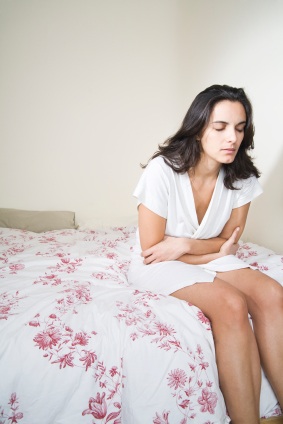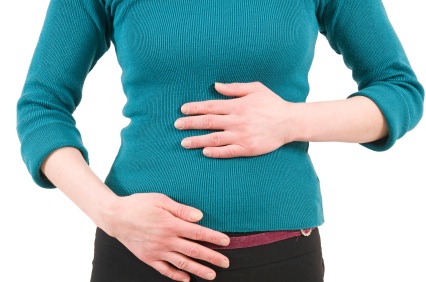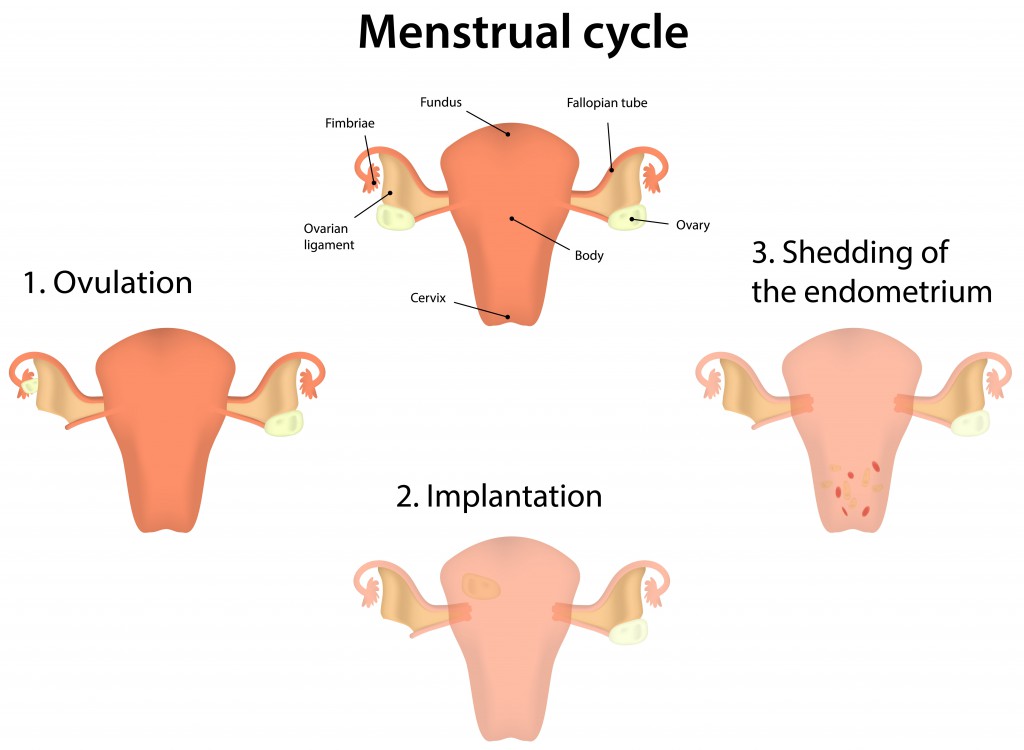Menstrual cramps experienced by a woman during her monthly menstrual period are pains that occur in the abdomen and pelvic area. To some extent, 50 percent of all women are affected by menstrual cramps and approximately 15 percent of these women have severe cramps. Ninety percent of girls still in their adolescence have cramps.
Menstrual cramps can be mild to severe and are different in every woman who has them. Mild cramps are short in duration and are sometimes only slightly noticeable. But some women suffer such severe cramps that it can interfere with their daily activities and may last for several days.
Types of Menstrual Cramps
Menstrual cramps can be one of two types: primary or secondary. Primary cramps are the type of menstrual cramps that are most common. Women can begin to have them with the onset of a their first period or they can begin after several years. They are caused by no physical abnormality of any kind. The secondary type of menstrual cramps have an underlying physical basis like pelvic inflammatory disease (PID), fibroids in the uterus, and other conditions discussed later.

Alternative Names
The medical term for common menstrual cramps is secondary dysmenorrhea and is often just referred to as dysmenorrhea. When there is underlying cause of the cramps, it is referred to as secondary dysmenorrhea.
Menstrual Cramps? Get Remedies Fast!
Symptoms
The pain from menstrual cramps starts in the lower abdomen and the pelvis and can extend to the lower back as well as the legs. For some women the pain may be only a dull ache while for others they are more painful.
Menstrual cramps usually begin before the period actually starts and will normally be the worst about 24 hours after they begin. They generally subside after one to two days. Other symptoms that may accompany cramps are:
- Headache
- Nausea, which can rarely be followed by vomiting
- Constipation
- Diarrhea (The prostaglandins cause the muscles of the intestinal tract to contract.)
- More frequent urination.
Primary Dysmenorrhea
Primary dysmenorrhea happens when the endometrium, which is the inner lining of the uterus, sheds as the menstrual flow each month. During the month, this lining is built up in order to make the uterus ready for a possible pregnancy. When an egg is not fertilized during ovulation to cause a pregnancy, the inner lining is not needed. The levels of estrogen and progesterone in the woman’s body decrease, the uterine lining swells and is released from the body as menstrual flow. When this is completed, the lining is replaced.
During the break down of the uterine lining, compounds known as prostaglandins are discharged, causing the muscles in the uterus to contract. This contraction causes less blood and oxygen to flow into the endometrium which makes it break down and die. When the tissue is dead, the contractions continue in order to push the dead tissue through the cervix and away from the body via the vagina.
Levels of other substances known as leukotrienes increase during this time as well. These chemicals are connected to the body’s inflammatory responses and may also play a role in causing menstrual cramps.
Cramps caused by this monthly process can be particularly severe when pieces of bloody tissue and clots are pushed out through the cervix. Women with a narrow cervical canal may experience these severe cramps.
The severity of cramps can often depend on the level of the prostaglandin in the body. Women with a higher amount of prostaglandin will have cramps while a woman with normal to low levels may not experience menstrual cramps.
There are other issues that can add to the severity of menstrual cramps. Emotional stress has been shown to increase the discomfort felt from cramps, as well as a lack of exercise.
Menstrual cramps caused by primary dysmenorrhea will normally lessen as the woman ages or after giving birth. It is believed that the nerves inside the uterus degenerate as they age. In a pregnant woman, these nerves deteriorate completely in the later stages of the pregnancy and only some of them are restored after childbirth.
Secondary Dysmenorrhea
Secondary dysmenorrhea is caused by some condition usually connected to the reproductive system and usually develops later in life rather when an adolescent begins her menstrual periods. Some of these conditions are:
- Endometriosis – This is a condition in which the tissue of the uterine lining affixes itself to other areas not in the uterus, causing lesions.
- Uterine polyps – These are growths that are attached to the inner wall of the uterus and protrude into the cavity of the uterus. They are caused by too much growth of cells in the endometrium.
- Pelvic inflammatory disease – This is an infection of the reproductive organs.
- Uterine fibroids – These are growths in the uterus whose development may be stimulated by estrogen and progesterone.
- Using an IUD for birth control.
Risk Factors
There are people who may be at a higher risk of primary menstrual cramps each month. This includes:
- ·Women who are under the age of 20
- Women who experienced an onset of puberty at age 11 or younger
- Having particularly heavy bleeding with their periods
- Having never been pregnant nor gone through childbirth
- Being significantly overweight or underweight.
- Smoking. Smokers have a 50 percent higher chance than women who don’t smoke of suffering from menstrual cramps.
- Women under high levels of stress.
Prevention Tips
There are ways that may work for some women to keep them from having menstrual cramps or at least reducing their severity. Many of these prevention tips are naturopathic solutions and can be used as treatments when menstrual cramps do occur.
- Get regular aerobic exercise.
- Talk to your doctor about taking birth control pills in order to stop the production of hormones that contribute to menstrual cramps.
- Cut back on coffee, decaffeinated coffee, and black tea, especially in the days before the period begins.
- Cut back on alcohol consumption.
- Reduce the amount of meat and dairy food in the diet. They can aid in the production of the prostaglandins that help to cause cramps.
- Cut back on salt before the period begins.
- Take a vitamin supplement that contains B3, E, magnesium citrate, and calcium citrate.
- Eat cold-water fish and/or take a fish oil supplement with Omega 3 and fatty acids. Doing this can inhibit the production of prostaglandins.
- Practice certain yoga positions to aid the proper balance of the uterine function.
- Avoid the use of intra-uterine devices (IUDs) as a method of birth control. These devices can increase menstrual cramps.
- Use sanitary pads instead of tampons.
Test and Diagnosis Considerations
A woman can generally diagnose menstrual cramps herself and it is based on her own perception of the pain. In the case of primary dysmenorrhea, most women know what the signs and symptoms are. However, women who experience more than two painful periods, particularly if the pain is disabling, should schedule an appointment with their gynecologist between periods.
In these cases, the gynecologist will likely perform a pelvic exam to ensure that there are no other causes for the pain.
For older women it is possible that the pain they are feeling is secondary dysmenorrhea and may be due to an underlying issue. Besides a pelvic exam, the doctor may perform an ultrasound to look for unusual growths or cysts on any of the reproductive organs.
If the cause of the cramps is undetermined after an ultrasound, the doctor may also insert a scope through a small cut below the navel in order to perform a more thorough examination of the region. This is called a laparoscopy.
A D&C, which is discussed in the section on Surgical Treatments is sometimes used to diagnose uterine conditions.
Treatment Options
Treatment for menstrual cramps can vary from woman to woman and may require some trial and error before finding the one that is right. Some of the prevention options mentioned previously work for many women like regular exercise, adequate rest and sleep, and yoga exercises. Heating pads and soaking in a hot bath have also been known to help.
There are various pharmaceutical treatments as well as herbal and home remedies and very rarely, surgical treatments that help relieve menstrual cramps. For each treatment, the level of efficacy may be different in every woman.
Pharmaceutical
There are several non-prescription drugs that can help control the pain of menstrual cramps, and in some cases, even prevent them. Aspirin and acetaminophen are enough for some women who have mild cramps. There are over-the-counter drugs made specifically to treat cramps that contain acetaminophen plus a diuretic.

Non-steroidal anti-inflammatory drugs (NSAIDs) are the best non-prescription option to treat menstrual cramps. Drugs that fall into this category are ibuprofen, naproxen, and ketoprofen.
It is best to begin taking these before the onset of cramps so the pain does not get too difficult to control. This could mean taking the pills as early as one or two days before the periods is due to start.
The medication should be taken one to two days after the period begins. There are also prescription strength NSAIDS that are available for treatment of menstrual cramps.
Oral Contraceptives
A method often used to treat severe menstrual cramps is taking oral contraceptives. Birth control pills contain estrogen and progestin and prevent ovulation, thus decreasing the amount of prostaglandins that are produced. This can makes the cramps much less severe and has the added advantage of causing a lighter menstrual flow.
While the use of an IUD for birth control can make menstrual cramps worse, one treatment option entails the use of an IUD that releases progestin directly into the uterus. This treatment has been shown to reduce menstrual cramps by 50 percent.
Herbal and Home Remedies
Many of the preventative measures listed for menstrual cramps are also good home remedies for when the cramps do manifest. Those, plus other herbal and home remedies can help to ease the discomfort of painful menstrual cramps.
Some people turn to Acupressure, this practice is based on the principles used in acupuncture, but instead of using needles on the acupuncture points, light pressure is applied. This practice is often recommended by those who practice alternative medicine for the relief of menstrual cramps.
The proper acupuncture point is called Spleen 6 and is approximately the width of four fingers above the bony part of the inner ankle, next to the shinbone and towards the back part of the calf. Slowly increasing pressure should be applied to this point using either the thumb or middle finger. Hold this for 3 minutes.
- Place a hot water bottle on your stomach. A damp towel heated in the microwave can also be used. This relaxes the muscles that cramp.
- Abdominal cramping can be relieved through orgasm. The muscle contractions that occur during an orgasm make the blood and other fluids leave organs that are congested.
- Drink two cups of peppermint or wintergreen tea a day. The mint leaves can be added to any type of tea. Also suck on mint candy on and off during the day.
- Drinking hot liquids can increase blood flow and relax muscles that cramp. Drink any herbal tea or heat up lemonade. Don’t drink any hot liquids that contain caffeine. Caffeine increases nervous energy and can make menstrual cramps worse.
- A hot bath with mineral salts can help relax muscles. Soak for at least 20 minutes.
- Basil has a natural painkiller called caffeic acid and it can relieve the pain menstrual cramping. To make a basil tea, put two tablespoons of basil leaves in a pint of boiling water. Allow this to steep covered until it comes to room temperature. To ease cramps, drink ½ cup to 1 cup of the tea every hour.
- Cinnamon has antispasmodic and anti-inflammatory properties. Sprinkle cinnamon in tea or on breakfast food.
- Calcium is well known to decreasing pain from menstrual cramps. Taking magnesium supplements both before the period begins and during it can help the body more effectively absorb the calcium in food and calcium supplements.
- Drink plenty of water. Dehydration can make menstrual cramps worse.
- Getting plenty of rest can help to decrease cramps.
Home remedies have the added advantage of being affordable and easily accessible.
Surgical Procedures
Surgical procedures are not often recommended for the treatment of menstrual cramps. In cases when a woman consistently has uterine bleeding that is unusually heavy and painful, a doctor may perform a procedure called an endometrial ablation. In this procedure, the uterine lining is destroyed using a device that generates heat like a laser beam, electricity, freezing, microwave, or heat produced by radio frequency. After the procedure, scars cause the endometrium to heal and this significantly reduces uterine bleeding and the severe cramps that go along with it.
The average fee for an endometrial ablation is $3,516, which does not include the hospital and anesthesia fees.
Another procedure to reduce heavy bleeding and cramping that used to be done more commonly in the past than it is today is called dilation and curettage (D&C). During this procedure, the cervix is expanded and a surgical instrument is inserted and used to remove tissue from the endometrium. This instrument is either sharp to scrape out the tissue or it sucks the tissue out. A D&C has minimal side effects. The most common is cramping.
If performed in a physician’s office, the cost can be low as lows $400. Performed at a surgical facility it can be as high as $2,000.
Treatment
The treatment for this type of menstrual cramps may be different depending on what the underlying cause is. Once the condition is diagnosed, the doctor will recommend the proper treatment.


6 Comments
I had believed I was post-menopausal until about 4 days ago. Approximately 30 years ago, at the age of 16, I was diagnosed with polymiocytis, a degenerative muscle disease, and was on high doses of steroids and a few different types of chemotherapy. When I was diagnosed, only 212 people in the U.S. had been diagnosed, and none were in my age bracket. I was even sent to the National Institutes of Health in Bethesda, MD, where they were still using my muscular samples and test results as the control, as of about 2005. My question is after not having a period for over 5 years (I began to stop producing estrogen at the age of 24) I’ve lost close to 80 pounds, and my body decided to be a girl again a few days ago. In the beginning, it was very old, dark brown blood, slowly turning to normal color. Although it isn’t heavy, the cramping is SEVERE and Ibuprofen (800mg q tid) isn’t even coming close to any relief. My primary physician is aware of my issue, she say’s it’s by body’s last effort to cycle again, probably initiated from the weight loss. I’m not looking for a miracle cure (or looking forward to having a monthly cycle again) but I would like some relief so I can get some things accomplished on my only day off. Any ideas?
Buy the herb Cramplex, you can get in on amazon. Its the only thing that’s worked for me in 20 years!!!
Hi Royce, look into magnesium (you can take magnesium baths, spray it on your skin or take it orally) and all the things it’s good for. Also look into a raw foods diet to give your body a health boost.
Marijuana and hash are excellent for cramps. I have used them for years.
Thank you for all the great tips for cramping. I was fortunate until about 20 yrs ago when cramping is involved. After birth of my first son at age 16, cramps began and have never left. Not to mention my period used to be 3-4 days long. Now 7-14 days in duration and severe ramping for 5-7 days I was looking for natural ways of coping. I’m trying herbal tea with peppermint & spearmint at this moment. Also I find that a nice warm or hot soakin tub always seems that it helps but the flow is heavier afterwards. I’m using a Sunbeam heated blanket for cramps right now. See I’m trying to get away from OTC meds. I relied heavily on Pamprin and then poof!!! They stopped selling it in not only my town but all of Canada. So I found the active ingredient in it pampron. Lucky me Rexall carries their own brand of midol with pampron in it but without the caffeine Midol has. After 3 yrs of using it I started to notice that as soon as possible when starting to Take a dose. Seems I’ve developed a new menstrual symptom nausea and vomitting and Its uncontrollable with the period meds. So I had to choose. I still get these symptoms just not as severe as with meds. I no longer take otc products for relief. Just natural ways of coping. Thank you so much for this article now I know what needs to be done. Thanks again for helping me see the light at the end of a dark tunnel.
Menstrual cramp was a nightmare for me. Lots of pills till I found the Magnetic therapy.
You can try “Therapeutic Magnetic Clip” that Amazon sales, it provides lot of relief.
Much better than alcohol or pain medications. Much less cost as well.